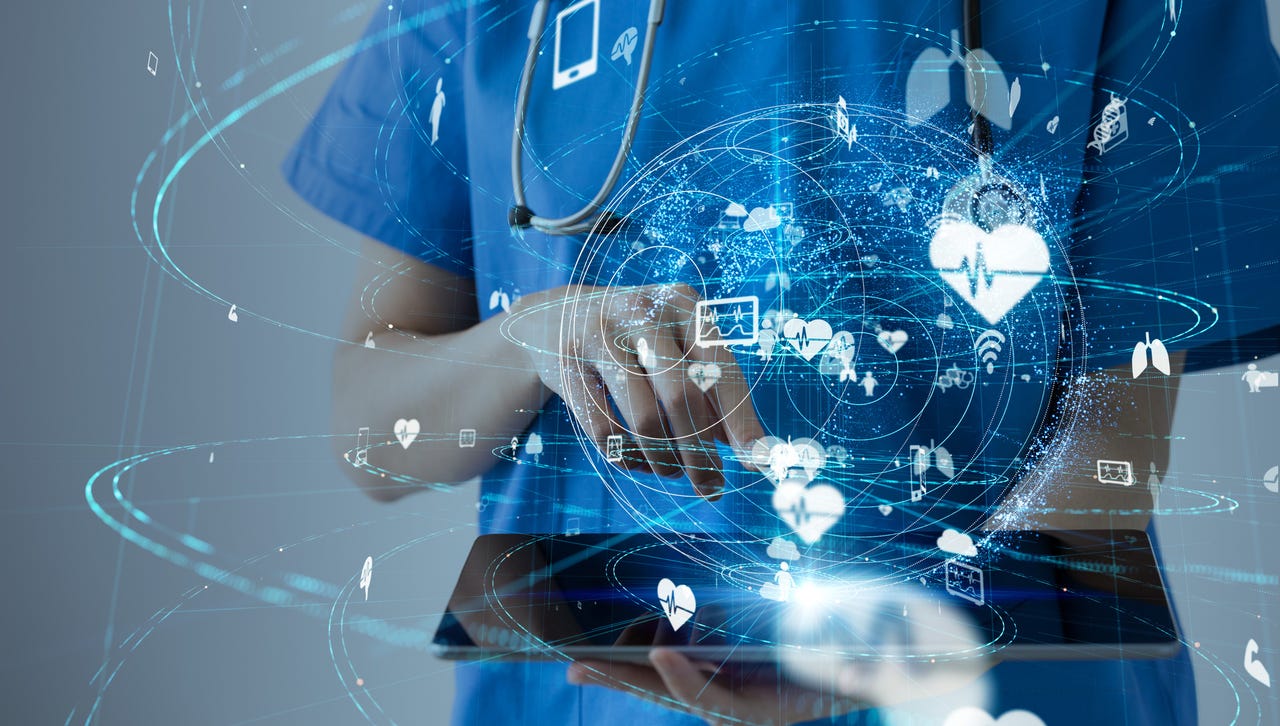3 innovative ways edge computing and 5G are transforming health care


Edge computing has the potential to transform hospitals and help medical staff in several ways. But what is it and how can it, along with 5G, provide patients with the best medical attention and treatment?
Edge computing is "the ability to push data and processing closer to the entity that is using the information, such as a medical device, fitness trackers, drone, or computer," Jack Fritz, a leader of the 5G and edge computing practice at Deloitte Consulting LLP, told ZDNET in an email.
In addition, "the dedicated bandwidth of the private 5G network makes it possible to connect more devices wirelessly -- from IoT (Internet of Things) equipment and sensors to handheld devices -- without quality concerns," said Sylvain Fabre, senior director analyst at Gartner, in an email to ZDNET.
Also: Ahead of AI this other technology is sweeping in fast
Along with wireless connection of multiple devices, Fabre also said that having private 5G on-site allows medical staff to harness and analyze data more quickly in a secure manner so that they can make decisions almost instantaneously.
Faster data processing closer to the source is important, especially in situations where a patient needs urgent medical attention. Here are ways that edge computing and 5G can help medical staff and patients in the realm of health care as they impact telemedicine, in-patient and out-patient monitoring, and emergency care.
1. Telemedicine and out-patient monitoring
Since the pandemic, telemedicine has become an even more convenient option than ever for those who are unable to make it to their doctor's appointments in person. The option to schedule a video visit also offers more flexibility for patients if they are far from a hospital. Now, edge computing could help patients who stay home for their appointments by allowing for faster transmission of data, such as medical records, for better results.
For instance, the AT&T Cybersecurity Insights Report distinguishes between traditional computing and edge computing by defining the latter as "happening outside traditional environments. In health care, this usually means it's happening in homes, laboratories, or in the field." According to the report, decisions can also be made closer to patients since the data is available near real time and can be analyzed quickly to treat patients in the best possible way without delay.
Also: Enterprises move to the edge, but the edge may not be ready
The AT&T report also mentions videoconferencing and remote sensors as two edge computing technologies that could create a hospital-like environment at home rather than having to travel to get to a hospital. This could be especially useful if you live in an area that is not close to a hospital, such as a rural area. As a result, there would be no concern for data processing latency through edge computing. Fritz said data would be stored closer to the source, so this could also lower the cost of data transmission while exchanging data more quickly.
In addition, business advisory firm PwC's Next in Health 2023 reports that many organizations will invest in health-monitoring devices such as wearable sensors. This way, a patient with a wearable could still keep track of their health when medical staff are performing other tasks.
"In theory, several medical devices have the ability to serve as an edge device. For example, a wearable that tracks heart rate and can infer arrhythmia without sending data back to the cloud, is considered an edge device," said Fritz, who is also principal in Deloitte's technology, media, and telecommunications practice. "In this instance, operations that require a quick response time occur on the device itself, alerting the user with a message, such as 'you are at risk of a heart attack.'"
Also: The future of cloud computing, from hybrid to edge to AI-powered
Similarly, Fabre said that patients with diabetes or cardiac issues could use wearables at home to track their health so they know when they are at risk or need assistance. This way, if further treatment is necessary, doctors can be prepared to take immediate action while patients will be notified of the status of their health without a doctor being physically present with them.
2. Emergency care
Edge computing and 5G could also help in situations where patients need emergency care outside of a hospital. According to the AT&T report, edge computing helps in emergencies by speeding up the diagnosis process and even implementing treatment of patients via telemedicine before they are transported to the hospital.
For instance, paramedics can treat patients in a time-efficient manner and make the best decisions by having access to patients' information while in the field with the patient rather than having to wait to take the patient back to the hospital to decide what the best treatment would be from their diagnosis. Another example of edge computing that the report mentions is the use of drones to deliver medical supplies for paramedics, such as medicine or even equipment. This could potentially save time that could be wasted if such delivery were to happen in traffic-heavy areas.
Also: The best drones: Which flying camera is right for you?
In the case where paramedics must bring the patient to the hospital, for instance, for surgery, doctors would be able to have all the relevant information prior to the patient's arrival.
The top five use cases for health care edge computing and their planned investments.
"Some early trials have focused on remote diagnostic procedures over 5G, enabling clinicians and paramedics to collaborate haptically, even when they are miles apart," Fabre said. If treatment is possible in the field, another advantage of edge computing could be freeing up more beds in the hospital for those who require in-patient care instead of using those beds for patients who can receive medical care outside of the hospital, as the AT&T report mentions.
Fabre gives examples of edge computing applications in emergency care, including using a camera in the ambulance that sends clear footage to a doctor with very low latencies. In turn, Fabre says the doctor could use a VR headset and joystick to provide remote assistance to the paramedic through haptic glove technology as they go through procedures to assess the wellness of a patient.
Also: What Verizon's 5G latest upgrade news actually means for users
When timing is essential in emergencies and processing data does not always happen instantaneously, a person's life may be on the line. Edge computing distributes data without the risk of delays. According to the AT&T report, "Distributed means things work faster because nothing is backhauled to a central processing area such as a data center and delivers the near-real-time experience."
This way, doctors, nurses, and paramedics don't have to wait to provide patients with the best care because of delays in the system. AT&T also reported that distributing data also lets organizations decide where the data is processed and kept, creating more efficiency among the medical staff.
3. In-patient monitoring
Fabre poses the possibility of 5G enabling a "'digital window' into patients rooms" through computer vision technology and smart cameras. This could allow nurses to prioritize patients who need more immediate care while also keeping track of patients' wellness from afar.
According to Fritz, virtual nursing care could also serve as a benefit from edge computing because nurses could monitor patients' vital signs from afar while also having the ability to act quickly if a patient's vital signs were to fluctuate.
Also: The best blood pressure watches
Fritz also emphasizes the power that cameras have with cameralytic technology by implementing features such as fall detection that could also help monitor the well-being of individuals when nurses aren't physically present.
In addition, robots also provide support in hospitals. Powered by edge computing, they can assist doctors and nurses around the clock. For instance, AT&T reports that these robots could clean patient rooms and transport supplies to various rooms that need equipment or medicine. In turn, doctors and nurses could focus on patient care.
Cybersecurity concerns with 5G and edge: What's being done
Despite the potential for edge computing to transform health care, there are still some concerns that must be addressed. PwC's Next in Health report says, "Health care is a major target for cyber crime." It cites that 63% of health sector leaders are concerned about cyber attacks occurring.
In addition, AT&T reported that edge computing could make sensitive data vulnerable to attacks or physical theft if a device is stolen. The report suggests that data encryption could help deter cyber crime, along with implementing the right network and cyber controls.
Also: AI and advanced applications are straining current technology infrastructures
Fritz also mentioned that edge computing or 5G should not entirely replace the system that an organization is currently using. Although some of the features of these capabilities work with other functions within an infrastructure, Fritz mentioned they "should be viewed as complementary to existing solutions." As edge computing and 5G usage become more prevalent, Fritz also says that regulations are coming to fruition to maintain the security and privacy of data.
PwC's Next in Health reports, "By 2030, we expect the sector to move into a new health ecosystem." According to PwC, this means that organizations that are sticking with traditional methods, such as using health care payers or providers, will not be able to stay up to date with implementing the latest edge computing into their organizations for better patient and medical staff experience.
5G and edge computing are promising features that could help medical staff process information efficiently through the near-instantaneous transfer of data. However, to provide the best patient care possible in a secure manner, it's still essential for health care facilities and hospitals to remain cautious when implementing 5G and edge computing in any current systems.